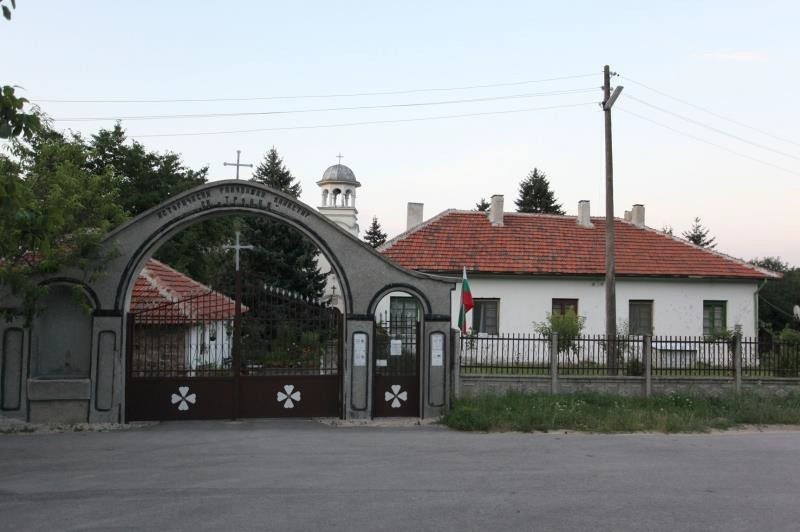

Rakovitsa Monastery of “St. Trinity” is located at the foot of Chernoglav Mountain in the western part, about 4 km from the village of Rakovica and 50 km southwest of Vidin, close to the border with Serbia.
The remotest historical data of the monastery are quite limited, founded in X-XI century. After the fall of Bulgaria into the Western Ottoman yoke, being destroyed several times during the Ottoman rule, the monastery miraculously preserved the ancient church. The last time the monastery was plundered in the nineteenth century during the rebellion led by Osman Pazvantoglu. (1758 – 1807 AD).
It was restored in 1825, as it is evidenced by a commemorative inscription within the ancient church. During the Bulgarian National Renaissance, Rakovitsa monastery became an important, spiritual, cultural and educational centre for Bulgarians in the area. In 1848 here was opened the first secular school in northwestern Bulgaria.
The name of the monastery was linked to the revolutionary struggle against Turks feudal oppression in 1848, organized also by Kyurtovska, in 1849 – Voynushkoto uprising in 1850, when it was written the letter to the Russian Emperor for help, and in 1856 – Timok rebellion and Moravia. As we know, here in 1850, have gathered sixty-one representatives of Kula, Vidin, Belogradchik and kaaza Lomski, who decided to organize a revolt against the Ottoman domination. On June 1st of the same year, the rebellion broke out and spread to a large part of the population who heroically and selflessly fought against the centuries old Ottoman oppressors. In memory of the rebels later killed, in the courtyard was built the great church from today (1944). It was built in the time of Abbess Haritina. In those 50 years of the twentieth century, the 13 nuns were expelled and riots broke out in various monasteries Dobridolski, Etropole, Darvenishka. During the communist regime the Rakovishki monastery itself had a border outpost. The old church walls were whitewashed to hide the frescoes and they have turned it into stables. Later, thanks to the efforts of vicar Bishop, then Vidin, Provadya Sofronii priest (later priest Dorostolo-Cherven), the Church regained the monastery for the cost of several hectares of land of the monastery on which they built some buildings that are now damaged. The name of the abbots who ruled the monastery from its release until today, are: Archimandrite Agapi, monk Chrysanthos, Monk Jacob, Yoanikii, nun Xenia, nun Pelagia, the nun Haritina, priest Provadya Sofronii, Archimandrite Ignatius, Archimandrite Jacob, Sevdalin Petrov, Archimandrite Antim. Rakovitsa Monastery is a complex of two churches, residential and agricultural buildings. The old Church has a Small Church with cross counsel, with the narthex (interior narthex) with a transversal cilindrical vault. This one has a dome and in many ways resembles the original Boyana church. According to some researchers, it is from the Xth or eleventh century, and after others it dates from XIIth – XIIIth century. The restoration of the church is associated with the name of Mount Athos, the painter – iconographer Pimen Sofia.
In 1825, the old church was completely renovated and decorated with murals. Masters painters were Krystju Zahariev (1785-1850) and Dosyu Koev (1790-1871), from the Tryavna art school. Due to limited murals within the church were illustrated a small number of evangelical themes. Relatively well preserved is an extensive composition of “Doomsday” written along the western wall of the small antechamber. The land is developed quite original, in a way that the Bulgarian churches were never painted before. The River of Fire, here it is traditionally described as a huge snake that comes from the mouth of the dragon – the Hell, Christ is being led and placed on a throne – as judge. The body of the snake is very curved and wrapped with a tape on which are listed the names of various mistakes. Tryavna painters capacity is put to the test to compose complex evangelical events on small fields.
Lime plaster today is carefully removed and are preserved the magnificent frescoes. Beneath the Renaissance mural painting it was discovered and older one that is still studied.
Inside the old church is the tomb of Captain Kiryaev who died in the Russo-Turkish war.
Currently in the Rakovitsa monastery is an active priest. Its abbot is Archimandrite Antim which in recent years has done everything possible to take the monastery into his power.
